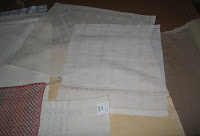Kati Reeder Meek taught us how to use a warping trapeze along with gravity and applied vibration to beam an evenly tensioned warp and to use live-weight tension to weave without stopping and retensioning the warp. In addition, Kati shared many of her best practices. (Click on any picture to enlarge.)
 Linen in various stages.
Linen in various stages. Some of Kati's woven linen samples.
Some of Kati's woven linen samples.
 Warping back to front using a trapeze. You can make your own trapeze (instructions in Kati's book) or you can purchase one from Purrington Loom Company. The trapeze is temporarily attached to the loom, lease sticks protecting the cross are attached, the end loops of the warp will be attached to the warp rod, the rattle is tied to the back beam, and the weights are then tied to the warp. We are now ready to spread out the threads in the rattle.
Warping back to front using a trapeze. You can make your own trapeze (instructions in Kati's book) or you can purchase one from Purrington Loom Company. The trapeze is temporarily attached to the loom, lease sticks protecting the cross are attached, the end loops of the warp will be attached to the warp rod, the rattle is tied to the back beam, and the weights are then tied to the warp. We are now ready to spread out the threads in the rattle. Stiff paper is inserted to separate the layers as we crank the warp on.
Stiff paper is inserted to separate the layers as we crank the warp on. Beaming on. During this phase the warp is spanked to vibrate the warp and even out tension.
Beaming on. During this phase the warp is spanked to vibrate the warp and even out tension. As the warp is cranked on, the weights rise to the top and need to be repositioned.
As the warp is cranked on, the weights rise to the top and need to be repositioned. Beaming on finished. The trapeze is removed.
Beaming on finished. The trapeze is removed. Threading the heddles. Kati believes in finding a comfortable position for seeing and reaching the heddles. This may mean your loom might need to be put up on blocks, tilted forward, or the shafts lifted. Position yourself as close to the heddles as possible.
Threading the heddles. Kati believes in finding a comfortable position for seeing and reaching the heddles. This may mean your loom might need to be put up on blocks, tilted forward, or the shafts lifted. Position yourself as close to the heddles as possible.  Sleying the reed with an automatic denter or reed hopper. The automatic reed hopper "walks" from dent to dent without ever leaving the reed. You can view a video clip of an auto-denter in use here. Kati uses the auto-denter a little differently but you will get the idea.
Sleying the reed with an automatic denter or reed hopper. The automatic reed hopper "walks" from dent to dent without ever leaving the reed. You can view a video clip of an auto-denter in use here. Kati uses the auto-denter a little differently but you will get the idea. Using the "click method". Kati attaches the warp threads to the cloth rod from the outside to the inside. She will advance the cloth ratchet one click every so often. The warp will be at very high tension at the end. The tension will backed off before weaving begins.
Using the "click method". Kati attaches the warp threads to the cloth rod from the outside to the inside. She will advance the cloth ratchet one click every so often. The warp will be at very high tension at the end. The tension will backed off before weaving begins.  Once the loom is fully dressed weights will be used in place of the braking system. Live-weight tension uses gravity to get the job done. The larger milk jug tension the warp by pulling down and the smaller water bottle provides a counterweight. The loom's brake is disengaged. As the warp is advanced the milk jug will rise until the water bottle touches the floor. Then the cord wrapped around the warp beam relaxes and the milk jug slips down until friction is restored. This is self-adjusting so there is no need to deal with the friction brake and readjusting the tension with each advance of the warp. Your warp will remain at the exact same tension.
Once the loom is fully dressed weights will be used in place of the braking system. Live-weight tension uses gravity to get the job done. The larger milk jug tension the warp by pulling down and the smaller water bottle provides a counterweight. The loom's brake is disengaged. As the warp is advanced the milk jug will rise until the water bottle touches the floor. Then the cord wrapped around the warp beam relaxes and the milk jug slips down until friction is restored. This is self-adjusting so there is no need to deal with the friction brake and readjusting the tension with each advance of the warp. Your warp will remain at the exact same tension. 


5 comments:
my mind is boggled!
Whoooweeee, that looks complicated! Fun, but complicated. I think I need to stick to the knitting needles and spinning wheel!
Wow, it looks fascinating. I'd love to see a loom in action.
What an excellent post. Kati's trapeze warping book is on my list of 'must gets.' Thanks for the pictures and details!
Way to go girl! An accomplished knitter and now a weaver with no boundries. Isn't it fun taking workshops?
AnneB
Post a Comment